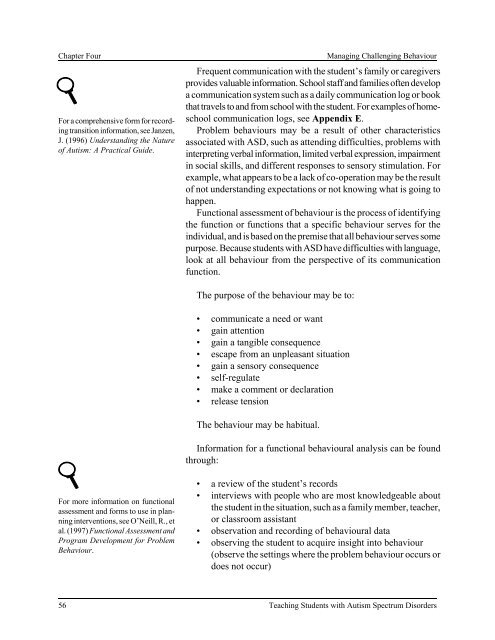Teaching Students with Autism Spectrum Disorders
Teaching Students with Autism Spectrum Disorders
Teaching Students with Autism Spectrum Disorders
Create successful ePaper yourself
Turn your PDF publications into a flip-book with our unique Google optimized e-Paper software.
Chapter Four Managing Challenging Behaviour<br />
For a comprehensive form for recording<br />
transition information, see Janzen,<br />
J. (1996) Understanding the Nature<br />
of <strong>Autism</strong>: A Practical Guide.<br />
For more information on functional<br />
assessment and forms to use in planning<br />
interventions, see O’Neill, R., et<br />
al. (1997) Functional Assessment and<br />
Program Development for Problem<br />
Behaviour.<br />
Frequent communication <strong>with</strong> the student’s family or caregivers<br />
provides valuable information. School staff and families often develop<br />
a communication system such as a daily communication log or book<br />
that travels to and from school <strong>with</strong> the student. For examples of homeschool<br />
communication logs, see Appendix E.<br />
Problem behaviours may be a result of other characteristics<br />
associated <strong>with</strong> ASD, such as attending difficulties, problems <strong>with</strong><br />
interpreting verbal information, limited verbal expression, impairment<br />
in social skills, and different responses to sensory stimulation. For<br />
example, what appears to be a lack of co-operation may be the result<br />
of not understanding expectations or not knowing what is going to<br />
happen.<br />
Functional assessment of behaviour is the process of identifying<br />
the function or functions that a specific behaviour serves for the<br />
individual, and is based on the premise that all behaviour serves some<br />
purpose. Because students <strong>with</strong> ASD have difficulties <strong>with</strong> language,<br />
look at all behaviour from the perspective of its communication<br />
function.<br />
The purpose of the behaviour may be to:<br />
• communicate a need or want<br />
• gain attention<br />
• gain a tangible consequence<br />
• escape from an unpleasant situation<br />
• gain a sensory consequence<br />
• self-regulate<br />
• make a comment or declaration<br />
• release tension<br />
The behaviour may be habitual.<br />
Information for a functional behavioural analysis can be found<br />
through:<br />
• a review of the student’s records<br />
• interviews <strong>with</strong> people who are most knowledgeable about<br />
the student in the situation, such as a family member, teacher,<br />
or classroom assistant<br />
• observation and recording of behavioural data<br />
• observing the student to acquire insight into behaviour<br />
(observe the settings where the problem behaviour occurs or<br />
does not occur)<br />
56 <strong>Teaching</strong> <strong>Students</strong> <strong>with</strong> <strong>Autism</strong> <strong>Spectrum</strong> <strong>Disorders</strong>

















